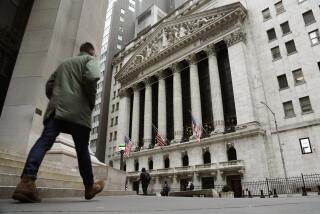Inflation Signs Drive Dow Into 150-Point Skid
- Share via
WASHINGTON — Two government reports--one showing that consumers have been on a spending binge, another that inflation may be creeping into the production pipeline--triggered another sell-off on Wall Street on Friday, sending stock prices below the level they were at when the year began.
The Dow Jones industrial average of blue-chip stocks lost 148.36 points in Friday’s trading to close at 6391.69, registering its fifth straight weekly loss. Other indexes also lost ground, driven down by declines in financial and technology stocks.
“It’s an extraordinarily wide, pervasive decline. It’s people wanting to reduce their exposure,” said Michael Metz, chief investment strategist for Oppenheimer & Co. On the New York Stock Exchange, six stock prices declined Friday for every one that rose.
On the bond market, where long-term interest rates are set, the yield on the benchmark 30-year U.S. Treasury bond rose to 7.16%, up two-thirds of a percentage point in just the past two months.
Analysts said the fresh economic data make it all but inevitable that the Federal Reserve will push rates even higher at its next regular meeting in May. Fed officials fear that the economy is growing so fast there is a serious risk of triggering inflation--a concern reiterated Friday by Fed Vice Chairman Alice Rivlin at a conference in Raleigh, N.C.
If history is any guide, the possibility of another increase in short-term interest rates will depress stock prices further in the coming months as the market adjusts to the prospect of lower profits and slower economic growth.
The Dow has already declined nearly 10% from its high of 7085 in March, the sharpest drop in three years. And David Shulman, chief strategist for the investment firm Salomon Brothers Inc., echoed the sentiments of many Wall Street analysts when he predicted Friday that “this correction has farther to go.”
*
The market’s skittishness was apparent from the opening bell Friday. Stock and bond prices went into a nose dive after the Commerce Department reported revised figures on retail sales showing that consumer spending rose at an annual rate of more than 5% during January, February and March, even after discounting for inflation. That would be the biggest jump in consumer spending since the economy began emerging from recession in 1992.
The surge in consumer spending during the first quarter suggests that the economy is not yet slowing, as some private forecasters and government officials had predicted, but may in fact be growing faster than it was at the end of last year. Other analysts, however, took comfort in the fact that the rate of increase in retail sales was much lower in March (0.2%) than in January or February.
Also Friday, the government reported that the producer price index, which measures the prices charged by manufacturers, rose by a surprisingly large 0.4%, excluding the volatile energy and food sectors. Much of the rise was driven by steep increases in the price of civilian aircraft and tobacco products, with lesser increases posted in the wholesale price of books, drugs and alcoholic beverages.
Food prices also rose 0.9%, the first increase since October, reflecting big increases in wholesale prices for fresh vegetables, meat, fish and coffee.
The Labor Department also found that year-over-year prices for intermediate goods (such as finished steel) and crude goods (such as scrap metal) were beginning to rise after falling for many months. The only significant bright spot in the price report was a sharp 3.4% drop in energy prices, which brought the overall producer price index down 0.1%, the third straight monthly decline.
“The best news on inflation is now behind us,” said economist Sung Won Sohn of Norwest Corp. in Minneapolis.
While most economists believe the economy is now growing at an unsustainable high rate, they remain divided on how quickly and easily it will downshift to a more comfortable cruising speed.
“I see no reason to question the consensus that we are going to see the economy begin to grow at a more sustainable [slower] rate later this year,” Robert Parry, the president of the Federal Reserve Bank of San Francisco, said in an interview Friday.
*
Mickey Levy, an economist at NationsBank Capital Markets, agreed. “The economy has done a marvelous job of self-correction in recent years, and I don’t have any reason to believe it won’t do it again. . . . Things are going to slow down later this year, no question.”
Among other factors, Parry and Levy cite the rising value of the dollar, which will raise the price of U.S. exports while lowering prices for imports. A rising dollar traditionally slows production--both at firms exporting goods and at firms producing goods that compete with imports.
But other analysts warn that the economy has now grown so fast for so long that the eventual process of deceleration-whether “natural” or prompted by Fed intervention-could prove somewhat painful.
“There’s a cycle out there, and it’s accelerating,” said Hugh Johnson, chief investment officer at First Albany Corp. “It’s looking more and more like a boom, to be followed at some time later by a bust.”
More to Read
Inside the business of entertainment
The Wide Shot brings you news, analysis and insights on everything from streaming wars to production — and what it all means for the future.
You may occasionally receive promotional content from the Los Angeles Times.










